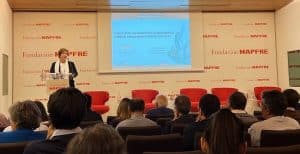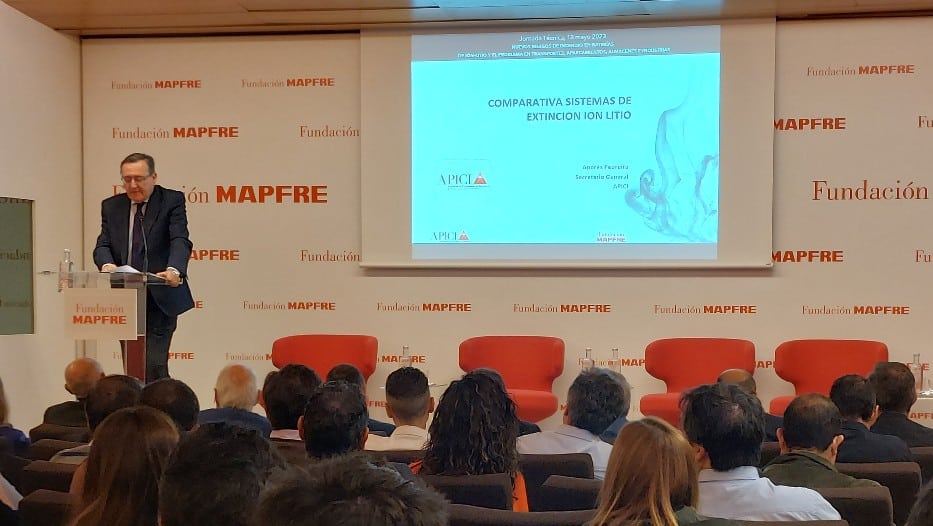Julia Maria Gomez de Avila Segade | 18/05/2023
On Thursday, May 18, APICI, the Association of Professionals of Fire Engineers, held its “New fire risks in lithium-ion batteries. Problems with transportation, parking lots, warehouses and industries” Technical Workshop Days at Fundación MAPFRE.
With a multidisciplinary program, both due to the topics covered and the professional profiles that encompassed it, APICI Technical Workshop Days have been a success, even exceeding the capacity of 105 people indicated in the room located in the central Paseo de Recoletos, 23.
With the welcoming of Jesús Monclús, director of the Accident Prevention and Road Safety Area of Fundación MAPFRE, and the introduction to the workshop by Andrés Pedreira, General Secretary of APICI, the first session entitled “Knowing the problem, protection and intervention” was kicked off. In this case, the moderator, Eduardo García Mozos, vice president of APICI and director of engineering at MAPFRE Global Risks, has asked the audience the question: “What are we dealing with when we talk about lithium-ion batteries? It is certainly a responsibility for each of us in our role in society.” And the program of the day has brought together engineers, insurers, occupational risk prevention entities, those responsible for safety measures of electric vehicles, fire safety agencies, battery manufacturers and also manufacturers of fire suppression systems, among others, and all, in one way or another, users of lithium-ion batteries.

In this first session, the situation of the electric vehicle market has been revealed by Sandra Pérez, CASE manager of CESVIMAP. In recent years, the number of 100% licensed electric vehicles has increased significantly: in 2018, there were around 6,500 units, compared to last year, when there were around 35,500. In the professional’s words, this increase is due not only to the society’s increased ecological awareness, but also to mobility restrictions in big city regulations.
With regard to the components of an electric vehicle, in addition to indicating that the rechargeable battery of a Tesla, for example, contains up to 7,000 batteries, Sandra Pérez has focused on the comparison between an electric and a combustion engine, since they differ in both the engine, itself, and fuel, in how they behave in the event of an accident and in contact with water.
“There are no technologies that can extinguish lithium-ion battery fires today, as oxygen is not needed to make the fire grow larger”
The second intervention was conducted by Luis Sánchez of JonhsonControl Tyco, and he discussed the detection systems and alternatives for extinguishing gases. In the event of a fire, the cells that make up the battery suffer a thermal increase, they are ignited by contagion without detecting smoke prior to the flame and the so-called “Thermal Runaway” occurs, a phase in which fire can no longer be avoided. “The more energy a battery stores, the more energy it expels.” In these cases, the batteries that make up them are fired “like bullets,” one of the audience assistants highlighted, adding that conventional fire suppression systems (water, dust…) are not as effective as when it comes to lithium-ion. “There are no technologies that can extinguish lithium-ion battery fires today, as oxygen is not needed to make the fire grow larger.”
Next, Rosenbauer’s Andrés Delgado, a manufacturer of fire, catastrophe, or civil protection vehicles, intervened to explain in depth the firefighting that their company performs. Regardless of the source of the fire (battery overheating or external reasons), they have designed an article that penetrates the battery by means of a piercing that expels water to cool the part and contain the temperature and finish up extinguishing the fire. While water shut-off in conventional mode consumes more than 30,000 liters, their method ensures that they consume between 600 and 1,000 liters.
 A key role in society are firefighters and both the Madrid fire department, represented by Manuel Ferrer and Barcelona fire department, represented by Víctor Molinet, were present on these technical workshop days. Manuel Ferrer put on the table the virulence with which the fires expand where lithium-ion batteries are involved. This inevitably brings up a key concern: “The problem is for all inhabitants as the evacuation time is shorter.” In this situation, he stresses the importance of “educating on charging correctly, not handling batteries, or charging where firefighters cannot access,” in addition to taking into account that the batteries inside the batteries are shoot out and cause a fire where they fall, so it is advisable to be aware of the risks to which we are exposed. For his part, Víctor Molinet recognizes that they are learning how to deal with this new challenge: fires that appear to be extinguished and, it turns out, can be reactivated after a few hours, even days. The city of counts, in this matter, has legislated by marking clear guidelines such as concrete signage, general power outage in the recharging installation and limiting the charging stations to floors below basements one floor underground (-1).
A key role in society are firefighters and both the Madrid fire department, represented by Manuel Ferrer and Barcelona fire department, represented by Víctor Molinet, were present on these technical workshop days. Manuel Ferrer put on the table the virulence with which the fires expand where lithium-ion batteries are involved. This inevitably brings up a key concern: “The problem is for all inhabitants as the evacuation time is shorter.” In this situation, he stresses the importance of “educating on charging correctly, not handling batteries, or charging where firefighters cannot access,” in addition to taking into account that the batteries inside the batteries are shoot out and cause a fire where they fall, so it is advisable to be aware of the risks to which we are exposed. For his part, Víctor Molinet recognizes that they are learning how to deal with this new challenge: fires that appear to be extinguished and, it turns out, can be reactivated after a few hours, even days. The city of counts, in this matter, has legislated by marking clear guidelines such as concrete signage, general power outage in the recharging installation and limiting the charging stations to floors below basements one floor underground (-1).
The second session, titled “Preventing risk in parking lots and transportation” was moderated by Fernando Vigara, vice president of APICI, and the first to intervene was our expert engineer at MAPFRE Global Risks, Maite Queralt. “Batteries are a very good thing, but there are risks from a prevention and insurance standpoint.” In this sense, insurers have to focus on very specific data such as the manufacture of the battery itself, the application it has, the repair shops and what the storage of said batteries has been or is. “Depending on the use of the batteries, different security measures will be applied; that is, the insurer will study on a case-by-case basis,” assessing the possibility of limiting the insured sum, coverages, and the inclusion of the deductible.
“Depending on the use of the batteries, different security measures will be applied; that is, the insurer will study on a case-by-case basis”
The contribution of Mónica Angulo, representing Iberdrola, was framed in a presentation entitled “Deployment of the recharging network and security at charging points.” She made known what the installation of charging points was like, mentioned the lack of existing regulations and opened an interesting debate with the audience in which she considered the possibility of human safety being put at risk by installing charging stations in spaces where the activity of the establishment that hosted said stations was not complementary. For example, installing recharging points in the vicinity of gas stations, as both facilities contain the risk of fire and, despite being located outdoors, would not be a safe area for people.
 The last interventions included Javier Unanua, from ARUP, and Aurelio Rojo, honorary chairman of APICI. The former provided relevant data such as the fact that the origin of 17% of electric vehicles burning is unknown, and 16% of electric vehicles burning during the charging process. He mentioned Norway, a country with a high percentage of electric vehicles, as an example: “Out of 45 recorded fires, only in one was the battery the cause.” He also noted that the electric vehicle fleet in Spain is much newer than that of combustion vehicles, so statistics cannot be compared, “so you will have to see what happens in the future when the electric fleet ages.” For his own part, Aurelio Rojo commented extensively on the “new hazards in metro systems and safety strategies” and shared his experience as a professional 20 years ago at the Madrid Metro. In this transport medium, it was innovated in 2003 with the installation of nebulized water systems. Today, it is an international reference for fire control. Car fires are currently increasing as the result of the movement of electric scooters, electric bicycles, motorized wheelchairs, as well as laptops, cell phones… To the extent that, as a preventive measure, scooter access has been prohibited in some cities, for example. Finally, Renfe Viajeros, represented by Eufemio Caballero, dealt with the new dangers to railroad transport.
The last interventions included Javier Unanua, from ARUP, and Aurelio Rojo, honorary chairman of APICI. The former provided relevant data such as the fact that the origin of 17% of electric vehicles burning is unknown, and 16% of electric vehicles burning during the charging process. He mentioned Norway, a country with a high percentage of electric vehicles, as an example: “Out of 45 recorded fires, only in one was the battery the cause.” He also noted that the electric vehicle fleet in Spain is much newer than that of combustion vehicles, so statistics cannot be compared, “so you will have to see what happens in the future when the electric fleet ages.” For his own part, Aurelio Rojo commented extensively on the “new hazards in metro systems and safety strategies” and shared his experience as a professional 20 years ago at the Madrid Metro. In this transport medium, it was innovated in 2003 with the installation of nebulized water systems. Today, it is an international reference for fire control. Car fires are currently increasing as the result of the movement of electric scooters, electric bicycles, motorized wheelchairs, as well as laptops, cell phones… To the extent that, as a preventive measure, scooter access has been prohibited in some cities, for example. Finally, Renfe Viajeros, represented by Eufemio Caballero, dealt with the new dangers to railroad transport.
The technical workshop was closed by the current president of APICI, Isolina Martínez, making a brief summary of the different interventions and highlighting the important responsibility that the different roles surrounding lithium-ion batteries have.
Keep reading… Electrical mobility: a sure bet for the energy transition in Mexico





